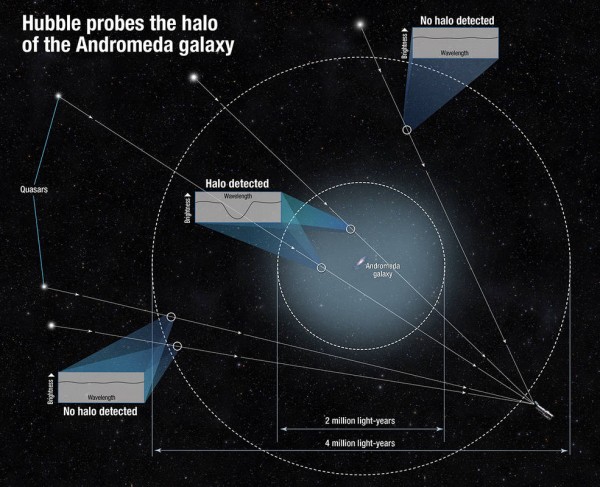Andromeda Galaxy's Ghostly Halo is 1000 Times Bigger Invading Milky Way Galaxy
| Ana Verayo | | May 08, 2015 11:00 AM EDT |
(Photo : NASA/STScI) The Andromeda galaxy, our nearest massive galactic neighbor, is about six times larger and 1,000 times more massive than previously measured.
A massive halo of cosmic gas that is surrounding the nearest galaxy to our Milky Way galaxy, the Andromeda Galaxy, is apparently much larger than previous observations acording to astronomers.
New measurements from the Hubble Space Telescope reveals that this almost invisible halo is about six times larger and even more than a thousand times as massive as previously thought.
Like Us on Facebook
This halo is enshrouding the Andromeda galaxy outward that spans almost a million light years which is reaching almost halfway towards our home, the Milky Way. This hot gas is also estimated to possess half of the mas of all the stars in Andromeda.
Scientists also believe that our own galaxy might also possess a similar halo which could mean that our neighbor galaxy could be exchanging interstellar material within the space between the two galaxies. Andromeda's halo can also provide important clues as how giant spiral galaxies form along with their structure and evolution.
According to Nicolas Lehner from the Notre Dame University, halos are considered to be the gaseous atmospheres of galaxies. The properties in which these gaseous halos possess can determine and control how fast stars form inside these galaxies based on galaxy formation models.
However, some halos are so tenuous that they are almost invisible that requires scientists to devise some techniques how to observe and detect them.
In this new study, scientists used ultraviolet wavlengths of 18 distant quasars to map out the halo of the Andromeda galaxy which is also known as the M31 galaxy.
According to astronomer J. Christopher Howk from Notre Dame University, Hubble detects the light from the quasar where the halo's gas will absorb some of that light that makes the quasar dimmer within a very small wavelength range.
This change in brightness can determine how much halo gas that the M31 galaxy has, between that quasar and all the way over Earth. Scientists say that this halo is made of hydrogen and helium which probably came to life the same time the Andromeda galaxy is also forming as heavier elements came in to the mix inside the galaxy via exploding supernovae.
During Andromeda's lifetime, these elements have been distributed all over, spanning outwards and even beyond the 200,000 light year diameter of the visible stellar disk.
Astronomers believe that in about 4 billion years, the Milky Way Galaxy and the Andromeda will collide and merge together that will form into one gigantic elliptical galaxy.
This study is published in The Astrophysical Journal.
Tagsandromeda galaxy, Hubble Space Telescope, Andromeda galaxy halo, NASA, hubble andromeda galaxy halo, milky way galaxy
©2015 Chinatopix All rights reserved. Do not reproduce without permission
EDITOR'S PICKS
-

Did the Trump administration just announce plans for a trade war with ‘hostile’ China and Russia?
-

US Senate passes Taiwan travel bill slammed by China
-

As Yan Sihong’s family grieves, here are other Chinese students who went missing abroad. Some have never been found
-

Beijing blasts Western critics who ‘smear China’ with the term sharp power
-

China Envoy Seeks to Defuse Tensions With U.S. as a Trade War Brews
-

Singapore's Deputy PM Provides Bitcoin Vote of Confidence Amid China's Blanket Bans
-

China warns investors over risks in overseas virtual currency trading
-

Chinese government most trustworthy: survey
-

Kashima Antlers On Course For Back-To-Back Titles
MOST POPULAR
LATEST NEWS
Zhou Yongkang: China's Former Security Chief Sentenced to Life in Prison

China's former Chief of the Ministry of Public Security, Zhou Yongkang, has been given a life sentence after he was found guilty of abusing his office, bribery and deliberately ... Full Article
TRENDING STORY

China Pork Prices Expected to Stabilize As The Supplies Recover

Elephone P9000 Smartphone is now on Sale on Amazon India

There's a Big Chance Cliffhangers Won't Still Be Resolved When Grey's Anatomy Season 13 Returns

Supreme Court Ruled on Samsung vs Apple Dispute for Patent Infringement

Microsoft Surface Pro 5 Rumors and Release Date: What is the Latest?










